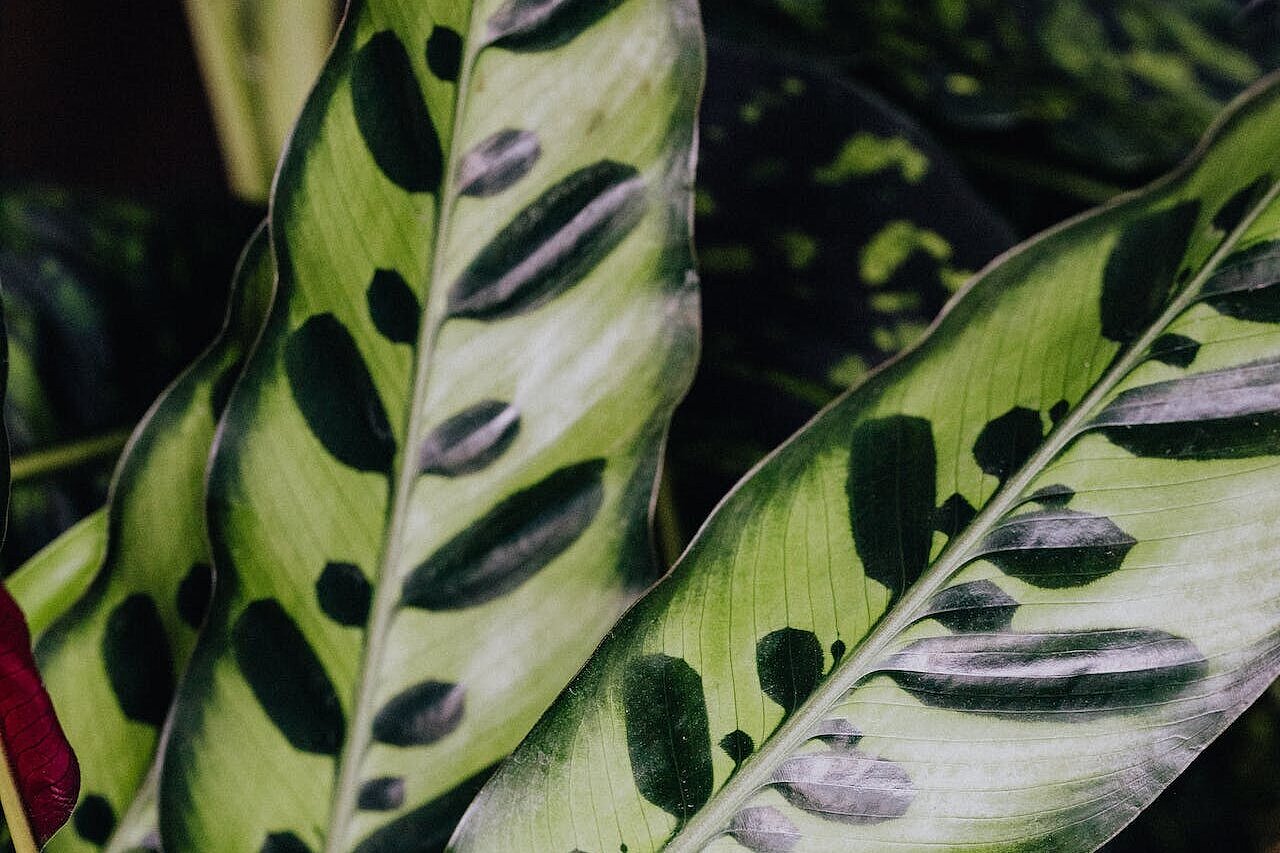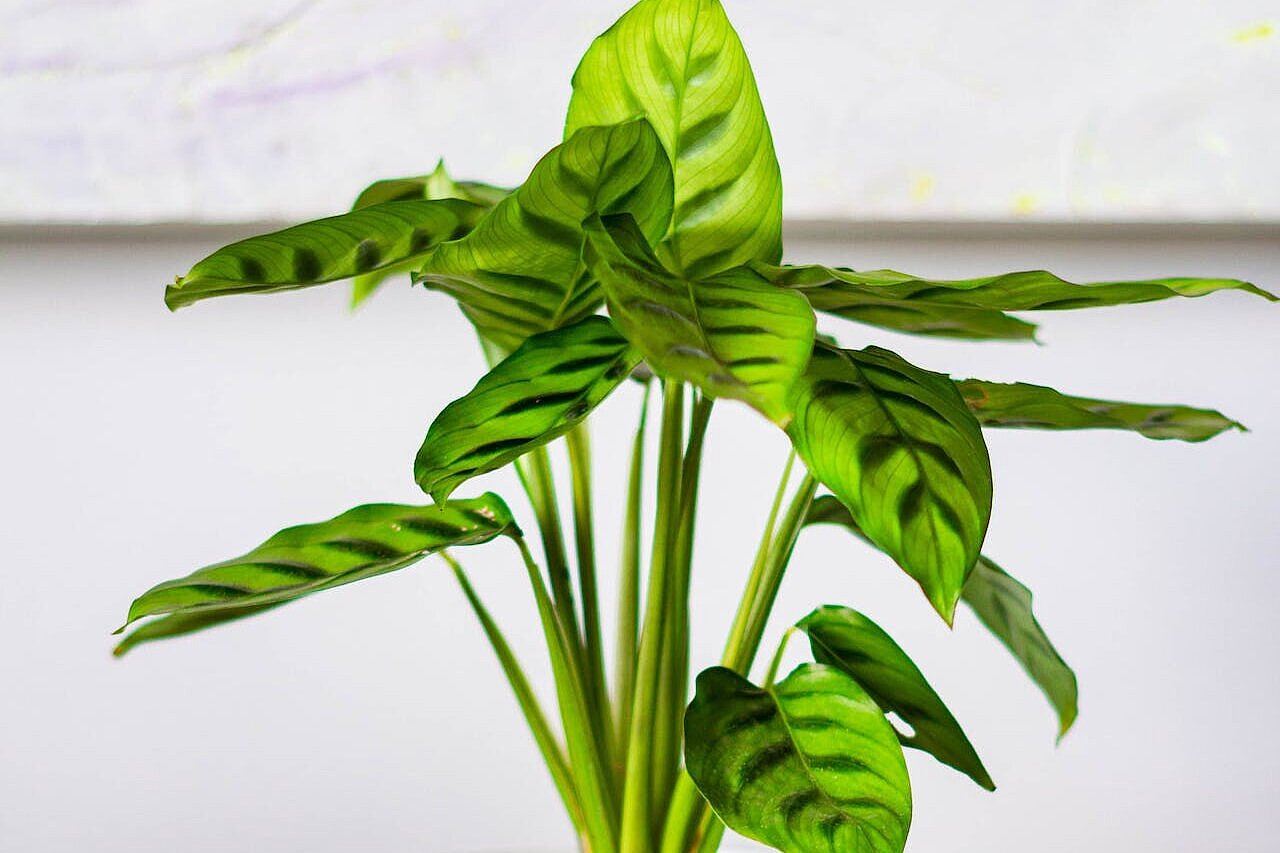Calathea ornata

What is Calathea ornata?
Calathea ornata is a perennial herbaceous plant from the Marantaceae family. It forms a rhizome-shaped rootstock from which numerous upright leaf shoots grow. The leaves are broad-lanceolate and have entire margins. They have a glossy surface and are decorated with a fine pattern of light lines. The underside of the leaf is dark red in color. The leaves can grow up to 30 centimeters long and have a long petiole.
Calathea ornata can also flower, but this is very rare in indoor cultivation. The flowers are arranged in upright spikes and are usually white or pink. The plant can grow up to 150 centimetres tall, although it tends to grow in height rather than width.
Is Calathea ornata poisonous to dogs?
The good news is: Calathea ornata is not poisonous to dogs (or cats). This means you can safely keep the plant in your home, even if you have a curious four-legged friend. Of course, you should still avoid letting your dog nibble on or damage the plant. This could lead to an upset stomach or irritation in the mouth. The plant would also suffer and lose its beauty.
So if you buy a Calathea ornata, it's best to put it in a place where your dog can't easily reach it. For example, on a high chest of drawers or a shelf. Or choose a hanging pot or hanging basket to let the plant dangle from the ceiling.
How do you care for Calathea ornata properly?
Calathea ornata is a demanding plant that needs a lot of attention. It likes it warm, moist and shady. If you can fulfill these conditions, you will be rewarded with a healthy and happy plant.
Location
Calathea ornata needs a bright spot, but not direct sunlight. The sun's rays can burn or bleach the delicate leaves. A spot in partial shade is ideal, for example in front of an east or west-facing window. You can also keep the plant in a shadier area, but then it will need less water and fertilizer and will grow more slowly.
The plant likes a warm and even temperature. The optimum temperature is between 18 and 25 degrees Celsius. Avoid draughts, cold and strong temperature fluctuations. In winter, the temperature should not fall below 15 degrees Celsius.
Watering
Calathea ornata needs plenty of water, but not waterlogged. The root ball should always be slightly moist, but not wet or muddy. Water the plant regularly with soft water (e.g. rainwater or stagnant tap water) and allow the top layer of soil to dry slightly between waterings. The plant needs more water in summer than in winter.
Make sure that the water can drain well and that no puddles form in the saucer or planter. This could lead to root rot or fungal diseases. Empty the saucer or planter after watering.
Humidity
Calathea ornata loves high humidity. This is not the case in most homes, especially in winter when the heating is on. You should therefore spray the plant regularly with soft water or use a humidifier. You can also place the plant in a small bowl filled with gravel or expanded clay and fill it up with water. However, make sure that the pot is not standing in water.
Another option is to place the plant together with other moisture-loving plants. This creates a small microclimate that increases the humidity. Or place the plant in a bathroom or kitchen, where the humidity is usually higher than in other rooms.
Fertilizing
Calathea ornata doesn't need much fertilizer, but a little nourishment won't do it any harm. You can feed the plant with a liquid green plant fertilizer every two to four weeks from March to September. Only use half or a quarter of the recommended dosage to avoid over-fertilizing. The plant does not need any fertilizer in winter.
Repotting
Calathea ornata grows relatively slowly and does not often need a larger pot. You can repot the plant every two to three years in spring if the pot becomes too small or the substrate is used up. Choose a pot that is only slightly larger than the old one and has good drainage. Use a loose and humus-rich substrate, for example a special basket potting soil or a mixture of potting soil, peat and sand.
When repotting, you can also carefully remove old substrate from the roots and remove dead or diseased roots. Place the plant as deep in the new pot as it was before and press the substrate down lightly. Then water the plant well.
Pruning
Calathea ornata does not need regular pruning, but you can remove dead or damaged leaves to keep the plant healthy and beautiful. Cut the leaves as close to the stem as possible and use clean, sharp scissors. Disinfect the scissors before and after cutting to prevent the transmission of diseases.
What varieties of Calathea ornata are there?
Calathea ornata comes in different varieties, which differ mainly in the color and pattern of the leaves. Here are some examples:
- Calathea ornata'Sanderiana': This variety has dark green leaves with white stripes and a purple-red underside.
- Calathea ornata 'Roseolineata': This variety has dark green leaves with pink stripes and a purple-red underside.
- Calathea ornata 'Pin Stripe': This variety has dark green leaves with very fine white stripes and a purple-red underside.
- Calathea ornata 'Beauty Star': This variety has dark green leaves with white and pink stripes and a purple-red underside.
Calathea ornata is a perennial herbaceous plant from the Marantaceae family, characterized by broad, glossy leaves with a fine light pattern and a dark red underside. It prefers warm, moist and shady conditions and can grow up to 150 centimetres high. Despite its demanding care, it is not poisonous to pets such as dogs. Proper care includes a bright location without direct sunlight, regular but not excessive watering with soft water, high humidity, occasional fertilization and infrequent repotting. Different varieties of Calathea ornata vary in the color and pattern of their leaves.
Properties 2
Are you looking for other ingredients with a specific property?
Just click on them to find more.
If you notice any signs of hypersensitivity or poisoning in your dog, you should see your vet immediately. We are not a substitute for a vet, but we try to be as accurate as possible. Every dog reacts differently and we recommend you get a second opinion or consult your vet if in doubt.
Stay healthy and take good care of your four-legged friend!😊
Similar to Calathea ornata
Calathea lancifolia belongs to the Marantaceae family, which is known for its diverse and decorative leaf patterns. The plant is characterized by its long, lancet-shaped leaves, which have unique...
Calathea makoyana belongs to the Marantaceae family and originates from the tropical regions of Brazil. It is characterized by its unique, decorative leaves, which have a striking pattern of light...
Calathea roseopicta is a demanding houseplant that needs plenty of moisture, warmth and light. It should be placed in a bright, but not directly sunny spot, otherwise the leaves may burn. The...
Calathea zebrina is an evergreen perennial that grows from rhizomes and reaches a height of up to one meter. The leaves sit on long, fleshy stems and are oblong-oval in shape. They can grow to over...



